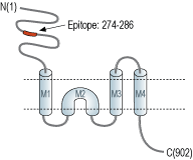Overview
- Peptide (C)KLMDRWKKLDQRE, corresponding to amino acid residues 274-286 of rat GluR4 (Accession P19493). Extracellular, N-terminus.

 Western blot analysis of rat brain membranes (lanes 1 and 3) and mouse brain lysate (lanes 2 and 4):1,2. Anti-GluR4 (GluA4) (extracellular) Antibody (#AGC-019), (1:200).
Western blot analysis of rat brain membranes (lanes 1 and 3) and mouse brain lysate (lanes 2 and 4):1,2. Anti-GluR4 (GluA4) (extracellular) Antibody (#AGC-019), (1:200).
3,4. Anti-GluR4 (GluA4) (extracellular) Antibody, preincubated with GluR4/GluA4 (extracellular) Blocking Peptide (#BLP-GC019).
- Santos, S.D. et al. (2009) Neuroscience 158, 105.
- Palmer, C.L. et al. (2005) Pharmacol. Rev. 57, 253.
- Monyer, H. et al. (1991) Neuron 6, 799.
- Dingledine, R. et al. (1999) Pharmacol. Rev. 51, 7.
- Malinow, R. et al. (2000) Curr. Opin. Neurobiol. 10, 352.
- Rumpel, S. et al. (2005) Science 308, 83.
- Morris, R.G. (2006) Eur. J. Neurosci. 23, 2829.
- Pastalkova, E. et al. (2006) Science 313, 1141.
- Whitlock, J.R. et al. (2006) Science 313, 1093.
Glutamate is the major excitatory neurotransmitter and modulates its effects via ionotropic and metabotropic receptors which are different in their molecular, biochemical, pharmacological and physiological properties1.
The ionotropic ligand-gated ion channel glutamate receptors are classified into three major subtypes, AMPA, kainate and NMDA receptors according to their selective agonist.
AMPA receptors consist of four closely related genes with about 70% homology that encode the four subunits GluR1-4. Their expression is known to be developmentally regulated2 and are also known to undergo alternative splicing. In fact, all four receptors have two splice variants, termed flip and flop, in an extracellular region adjacent to the M4 transmembrane region3. These splice variants are also developmentally regulated such that flip is expressed before birth and remains highly expressed throughout adulthood whereas flop expression is postnatal and reaches flip’s level in adulthood4.
In addition to their expression regulation, flip and flop also differ in their activation/inactivation kinetics. Each AMPA receptor contains 3 membrane spanning domains (M1, M3 and M4), while the fourth hydrophobic domain (M2) is a reentering cytoplasmic loop that forms part of the channels pore1. Different stoichiometries of these receptors form tetrameric structures to eventually form functional receptors5.
AMPA receptors are highly expressed in the brain. However, the GluR4 subunit is present in lower amounts in the CNS, except in the reticular thalamic neuclei and the cerebellum1.
The primary depolarization in glutamate neurotransmission is mediated by AMPA receptors, which are also key players in synaptic plasticity, learning and memory formation. The cellular distribution and post-translational modifications like phosphorylation are important for the activity of AMPA receptors and are thought to play a role in the long lasting and activity-dependent changes in synaptic strength6-9.
Application key:
Species reactivity key:
Alomone Labs is pleased to offer a highly specific antibody directed against an epitope of the rat ionotropic glutamate receptor 4. Anti-GluR4 (GluA4) (extracellular) Antibody (#AGC-019) can be used in western blot and immunohistochemistry applications. It has been designed to recognize GluR4 from rat, mouse, and human samples.
Applications
Citations
- Rat brain sections.
Ganea, D.A. et al. (2015) Neuropsychopharmacology 40, 2727.

